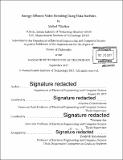Energy-efficient video decoding using data statistics
Author(s)
Tikekar, Mehul (Mehul Deepak)
DownloadFull printable version (14.88Mb)
Other Contributors
Massachusetts Institute of Technology. Department of Electrical Engineering and Computer Science.
Advisor
Anantha Chandrakasan and Vivienne Sze.
Terms of use
Metadata
Show full item recordAbstract
Video traffic over the Internet is growing rapidly and is projected to be about 82% of the total consumer Internet traffic by 2020. To address this, new video coding standards such as H.265/HEVC (High Efficiency Video Coding) provide better compression especially at Full HD and higher video resolutions. HEVC achieves this through a variety of algorithmic techniques such as larger transform sizes and more accurate inter-frame prediction. However, these techniques increase the complexity of software and hardware-based video decoders. In this thesis, we design a hardware-based video decoder chip that exploits the statistics of the video to reduce the energy/pixel cost in several ways. For example, we exploit the sparsity in transform coefficients to reduce the energy/pixel cost of inverse transform by 29%. With the proposed architecture, larger transforms have the same energy/pixel cost as smaller transforms owing to their higher sparsity thus addressing the increased complexity of HEVC's larger transform sizes. As a second example, the energy/pixel cost of inter-prediction is dominated by off-chip memory access. We eliminate off-chip memory access by using on-chip embedded DRAM (eDRAM). However, eDRAM banks spend 80% of their energy on frequent refresh operations to retain stored data retention. To reduce refresh energy, we compress the video data stored in the eDRAM by exploiting spatial correlation among pixels. Thus, unused eDRAM banks can be turned off to reduce refresh energy by 55%. This thesis presents measured results for a 40 nm CMOS test chip that can decode Full HD video at 20 - 50 frames per second while consuming only 25 - 31 mW of system power. The system power is 6 times lower than the state-of-the-art and can enable even extremely energy-constrained wearable devices to decode video without exceeding their power budgets. The inverse transform result can enable future coding standards to use even larger transform sizes to improve compression without sacrificing energy efficiency.
Description
Thesis: Ph. D., Massachusetts Institute of Technology, Department of Electrical Engineering and Computer Science, 2017. Cataloged from PDF version of thesis. Includes bibliographical references (pages 103-108).
Date issued
2017Department
Massachusetts Institute of Technology. Department of Electrical Engineering and Computer SciencePublisher
Massachusetts Institute of Technology
Keywords
Electrical Engineering and Computer Science.